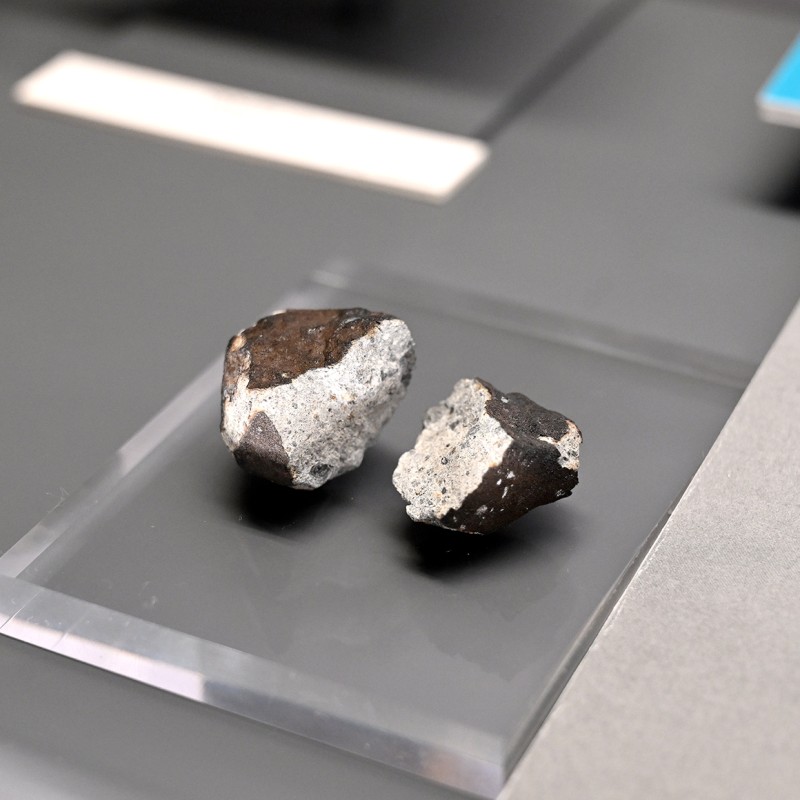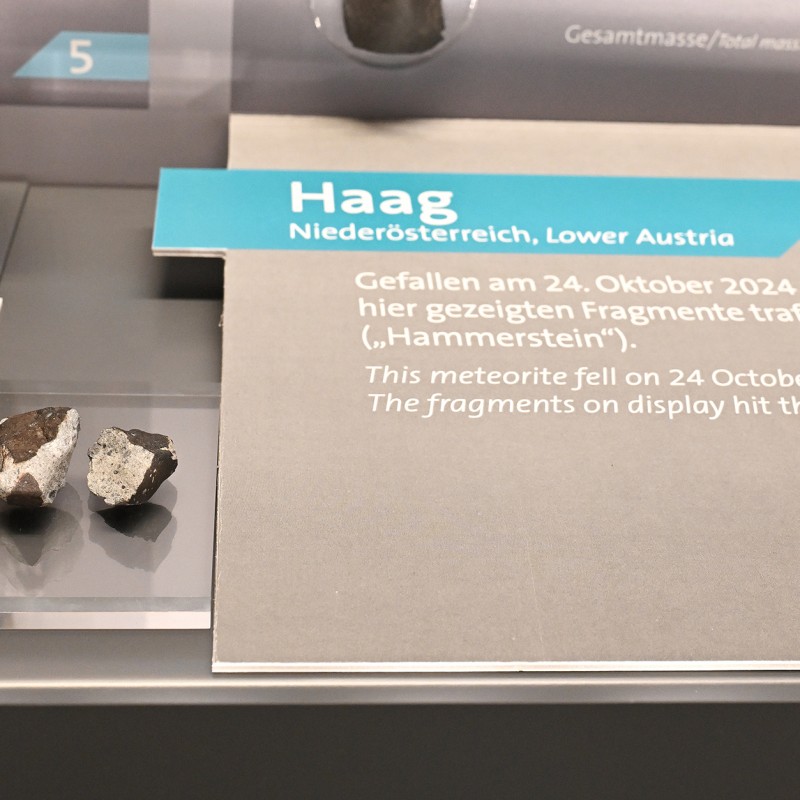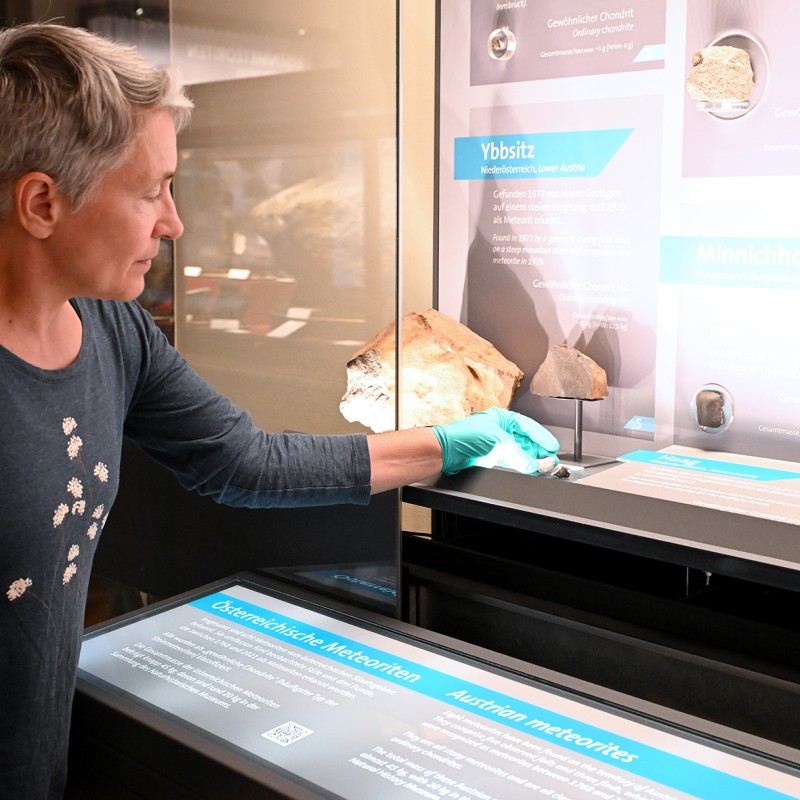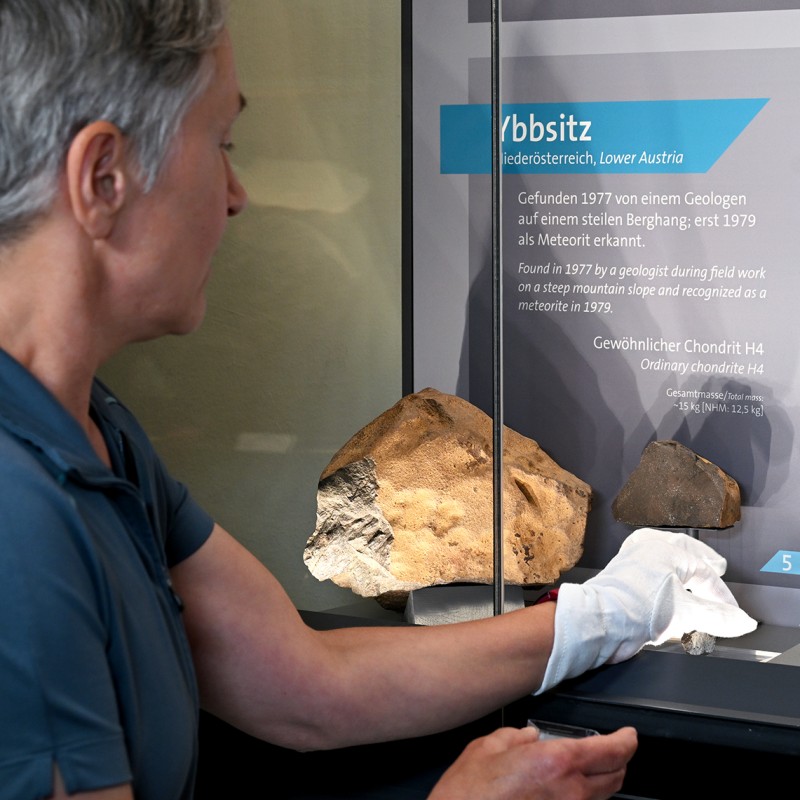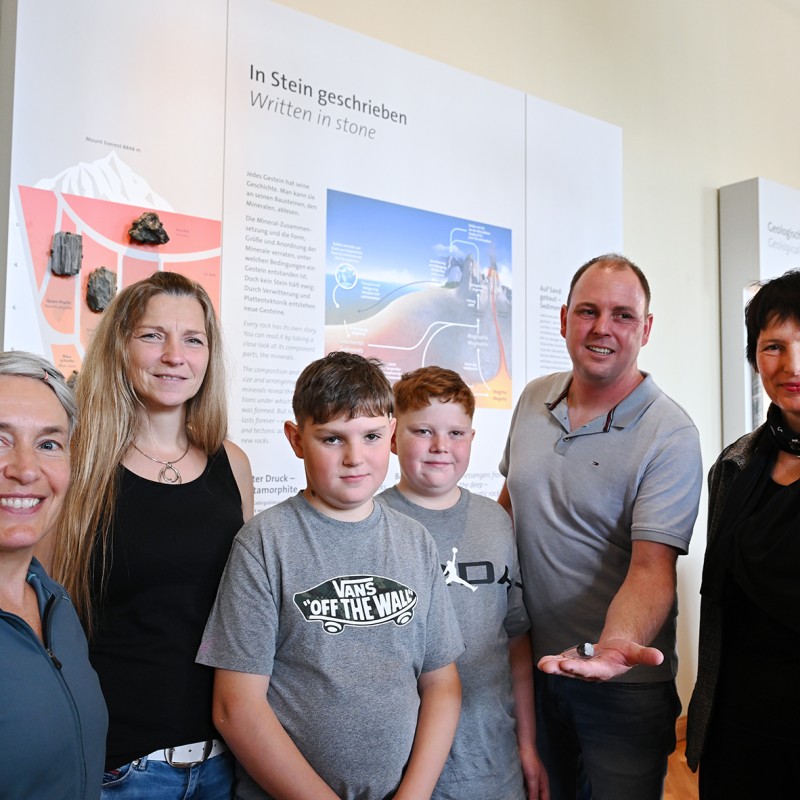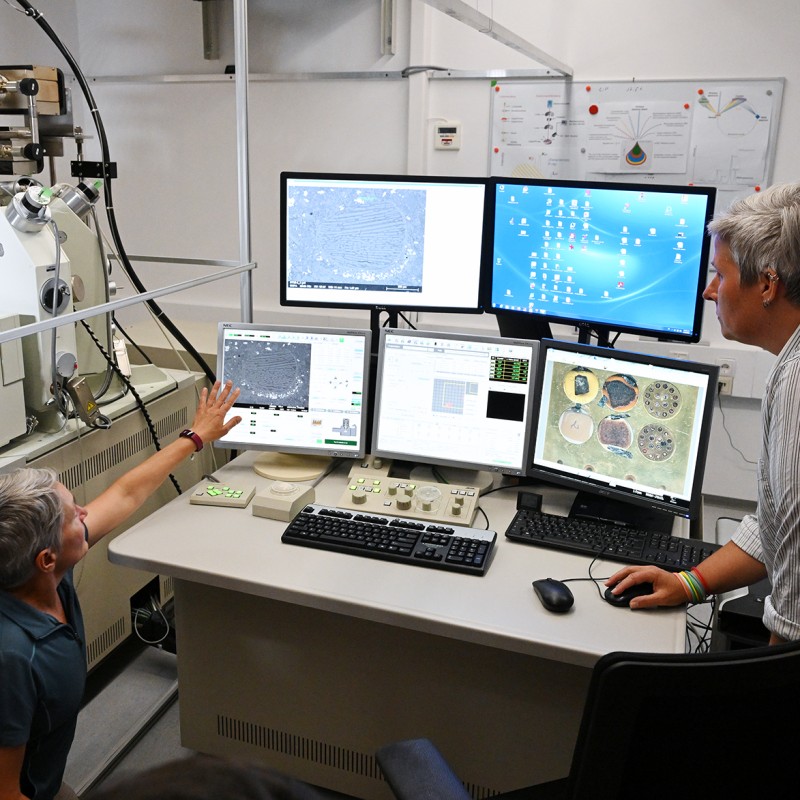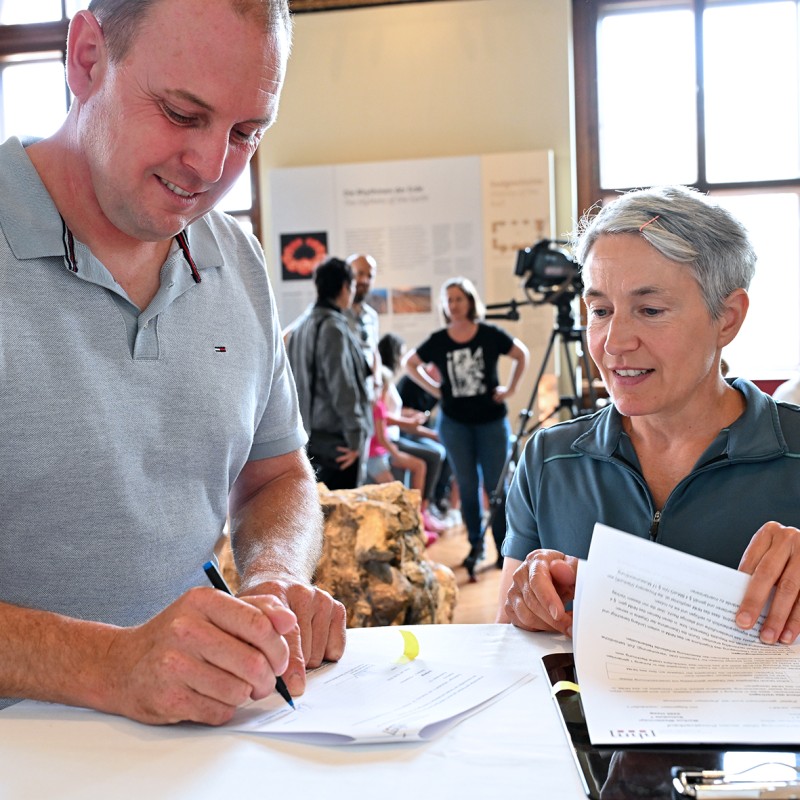Press event: Presentation of the Haag meteorite at the Natural History Museum Vienna
10. June 2025
On Tuesday, 10 June 2025, at 10:30 a.m., the Westermayr family will present the Haag meteorite to the NHM’s meteorite
collection.
Programme:
10:00 a.m.: get-together in Hall 6 “Planet Earth”
10:30 a.m.: Meteorite Hall (Hall 5); handover and brief guided tour
Welcome by Dr. Katrin Vohland, Director General/CEO
The Haag meteorite is handed over by the Westermayr family and placed in the “Austrian Meteorites” display case; scientific information provided by Dr. Andrea Patzer, curator of the meteorite collection, Mineralogy & Petrography Department, NHM Vienna
11:15 a.m. Visit of the electron microscopy laboratory with Dr. Wencke Wegner, operator for microanalysis, Central Research Laboratories, NHM Vienna
Prominent newcomer in the Austrian Meteorites display case
Having landed near Haag in Lower Austria on 24 October 2024, the Haag meteorite is one of the most important meteorite discoveries of recent decades in Austria. It entered the Earth’s atmosphere around 21:25 CEST as a bright fireball that was visible across wide parts of Austria and neighboring countries. The meteorite burst into several fragments that scattered over a narrow perimeter of about 9 km in length between Lembach and Bachlerboden (part of Haag).
A particularly remarkable fragment landed on the roof of a house in Schudutz near Haag, the home of the Westermayr family. At impact, the fragment broke into three parts which fell on the asphalted parking space behind the house. In German, meteorites that impact man-made structures are called Hammersteine (“hammer rocks”). In Austria, this was the first such event ever!
The great majority of meteorites officially registered with the international Meteoritical Society’s Nomenclature Committee (Meteoritical Bulletin) are so-called “finds”, meaning such rocks were identified as meteorites only after having been found by deliberate search or by accident. If the arrival of the meteorite was witnessed and it could then be recovered, one speaks of meteorite “falls”.
In Austria, there have so far been three finds and five falls. The relatively small number of finds can be explained by the terrain, which in most parts of the country is not really conducive to the discovery of meteorites, because it is covered by vegetation, water or crops, or it is steep and inaccessible. Meteorites are much more readily found in deserts on surfaces that are light colored, flat and only sparsely covered by vegetation, or else on the large open ice fields of Antarctica.
The last fall, exhibited in the Austrian Meteorites display case at Hall 5 of the Natural History Museum Vienna, was named Kindberg (meteorites are always named after the place in whose vicinity they fell or were found). The Kindberg meteorite fell on 19 November 2020 in Mürztal, Styria. The previous falls occurred in 1768, 1905, 1925 and 1932.
At the most recent fall on 24 October 2024 at 9.24 p.m. in Haag, Lower Austria, the camera of the European Fireball Network observed that the meteorite broke into several fragments upon its descent through the atmosphere. This prompted calculations of a so-called scatter field for the individual fragments. On 30 October 2024, the NHM Vienna launched a media appeal to notify finds under https://nhm.at/meteorite.
The fragments recovered by the Westermayr family (28.6 gr. in three fragments) were acquired by the NHM Vienna and will as of now be displayed at the Austrian Meteorites display case in the Meteorite Hall of the NHM . Scientific investigations have identified the meteorite as being a chondrite that formed approx. 4.5 billion years ago during the early stages of the solar system. Chondrites are the largest meteorite class, taking their name from small silicate spheres (called chondrules) that are embedded in a fine-grained matrix.
The Natural History Museum in Vienna is home to one of the world’s largest meteorite collections.
With more than 10,300 items (over 2550 different meteorites), the collection ranks third in the world, surpassed only by the U.S. National Museum in Washington, D.C., and the large collection of Antarctic meteorites in Tokyo (National Institute of Polar Research).
Hall 5 of the Natural History Museum Vienna boasts the world’s oldest exhibition of meteorites. The Hraschina meteorite of 1751 was the first object identified as a meteorite in what was then the Imperial-Royal Natural Collection. Completely refurbished and modernized in 2012, Hall 5 now has approximately 1,100 meteorites on display.
Scientific enquiries:
Dr. Andrea Patzer, curator of the meteorite collection, Mineraloy & Petrography Department, NHM Vienna
https://orcid.org/0000-0003-2224-3452
andrea.patzer@nhm.at
Tel.: +43 (1) 52177 – 393
General enquiries:
Mag. Irina Kubadinow, Leitung Presseabteilung, Pressesprecherin, NHM Wien
https://www.nhm.at/irina_kubadinow
Tel.: + 43 (1) 521 77 – 410 | irina.kubadinow@nhm.at
Mag. Nikolett Kertész-Schenk, Bakk. BA MAS, Pressereferentin, NHM Wien
https://www.nhm-wien.ac.at/nikolett_kertesz
Tel.: + 43 (1) 521 77 – 626 | nikolett.kertesz@nhm.at
10:00 a.m.: get-together in Hall 6 “Planet Earth”
10:30 a.m.: Meteorite Hall (Hall 5); handover and brief guided tour
Welcome by Dr. Katrin Vohland, Director General/CEO
The Haag meteorite is handed over by the Westermayr family and placed in the “Austrian Meteorites” display case; scientific information provided by Dr. Andrea Patzer, curator of the meteorite collection, Mineralogy & Petrography Department, NHM Vienna
11:15 a.m. Visit of the electron microscopy laboratory with Dr. Wencke Wegner, operator for microanalysis, Central Research Laboratories, NHM Vienna
Prominent newcomer in the Austrian Meteorites display case
Having landed near Haag in Lower Austria on 24 October 2024, the Haag meteorite is one of the most important meteorite discoveries of recent decades in Austria. It entered the Earth’s atmosphere around 21:25 CEST as a bright fireball that was visible across wide parts of Austria and neighboring countries. The meteorite burst into several fragments that scattered over a narrow perimeter of about 9 km in length between Lembach and Bachlerboden (part of Haag).
A particularly remarkable fragment landed on the roof of a house in Schudutz near Haag, the home of the Westermayr family. At impact, the fragment broke into three parts which fell on the asphalted parking space behind the house. In German, meteorites that impact man-made structures are called Hammersteine (“hammer rocks”). In Austria, this was the first such event ever!
The great majority of meteorites officially registered with the international Meteoritical Society’s Nomenclature Committee (Meteoritical Bulletin) are so-called “finds”, meaning such rocks were identified as meteorites only after having been found by deliberate search or by accident. If the arrival of the meteorite was witnessed and it could then be recovered, one speaks of meteorite “falls”.
In Austria, there have so far been three finds and five falls. The relatively small number of finds can be explained by the terrain, which in most parts of the country is not really conducive to the discovery of meteorites, because it is covered by vegetation, water or crops, or it is steep and inaccessible. Meteorites are much more readily found in deserts on surfaces that are light colored, flat and only sparsely covered by vegetation, or else on the large open ice fields of Antarctica.
The last fall, exhibited in the Austrian Meteorites display case at Hall 5 of the Natural History Museum Vienna, was named Kindberg (meteorites are always named after the place in whose vicinity they fell or were found). The Kindberg meteorite fell on 19 November 2020 in Mürztal, Styria. The previous falls occurred in 1768, 1905, 1925 and 1932.
At the most recent fall on 24 October 2024 at 9.24 p.m. in Haag, Lower Austria, the camera of the European Fireball Network observed that the meteorite broke into several fragments upon its descent through the atmosphere. This prompted calculations of a so-called scatter field for the individual fragments. On 30 October 2024, the NHM Vienna launched a media appeal to notify finds under https://nhm.at/meteorite.
The fragments recovered by the Westermayr family (28.6 gr. in three fragments) were acquired by the NHM Vienna and will as of now be displayed at the Austrian Meteorites display case in the Meteorite Hall of the NHM . Scientific investigations have identified the meteorite as being a chondrite that formed approx. 4.5 billion years ago during the early stages of the solar system. Chondrites are the largest meteorite class, taking their name from small silicate spheres (called chondrules) that are embedded in a fine-grained matrix.
The Natural History Museum in Vienna is home to one of the world’s largest meteorite collections.
With more than 10,300 items (over 2550 different meteorites), the collection ranks third in the world, surpassed only by the U.S. National Museum in Washington, D.C., and the large collection of Antarctic meteorites in Tokyo (National Institute of Polar Research).
Hall 5 of the Natural History Museum Vienna boasts the world’s oldest exhibition of meteorites. The Hraschina meteorite of 1751 was the first object identified as a meteorite in what was then the Imperial-Royal Natural Collection. Completely refurbished and modernized in 2012, Hall 5 now has approximately 1,100 meteorites on display.
Scientific enquiries:
Dr. Andrea Patzer, curator of the meteorite collection, Mineraloy & Petrography Department, NHM Vienna
https://orcid.org/0000-0003-2224-3452
andrea.patzer@nhm.at
Tel.: +43 (1) 52177 – 393
General enquiries:
Mag. Irina Kubadinow, Leitung Presseabteilung, Pressesprecherin, NHM Wien
https://www.nhm.at/irina_kubadinow
Tel.: + 43 (1) 521 77 – 410 | irina.kubadinow@nhm.at
Mag. Nikolett Kertész-Schenk, Bakk. BA MAS, Pressereferentin, NHM Wien
https://www.nhm-wien.ac.at/nikolett_kertesz
Tel.: + 43 (1) 521 77 – 626 | nikolett.kertesz@nhm.at

